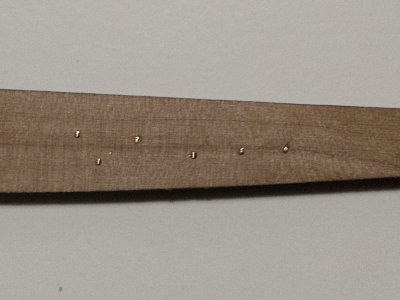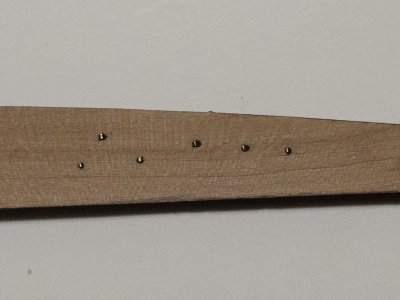I don't feel like every one of us is making models with the expectations of getting them into a museum. I pay a lot for my models, at the end of the day I want them to make me happy. I don't agree that there is a right or wrong way to make models, I think you should do them to the best of your abilities, but I'll how you make them up to you. If you like how the nails look, then I 100% back you up. In fact, I prefer them, but I prefer they be pre-drilled or laser cut to help with locating during glue up. This was how the longboat I am working on was done and it yielded amazing results. Destroyed my sandpaper, but oh well.
It's most definitely true that few hobbyists making ship models expect their models to be exhibited in a museum. Many certainly do pay a lot for their models and build them because it makes them feel good. There's nothing at all wrong with that!
That said, there certainly is a "right way and a wrong way to make models." I think the point you are actually trying to make is that the extent to which a given modeler cares whether their model is "right or wrong" is entirely up to them, an assertion with which I entirely agree. It's a maxim of naval architecture that "the design of every vessel is a collection of compromises." The same applies in the case of ship models.
In a ship modeling forum, when someone asks how to do something, the proper response is to provide the "right way" to do it based upon the highest standards and best practices recognized by and adhered to by serious ship modeling artists. There'd be little point in answering, "Do it however you damn please, because there's no right way or wrong way to build a ship model."
In the United States the standards and best practices for good ship models have been codified in two somewhat overlapping documents. The first is the Ship Model Classification Guidelines published by the Department of Ship Model Sales and Service, Mystic Seaport Museum, in Mystic, CT. These guidelines are used by Mystic Seaport, the Smithsonian Institution, The Mariners Museum, and other museums, many competitive ship model exhibitions, and marine art galleries to classify and evaluate models. (See: https://www.shipmodel.com/2018SITE/...ship-model-classification-guidelines-1980.pdf ) The second is the U.S. Navy Sea Systems Command's ("NAVSEA") Specifications for Building Exhibition Ship Models. (See: https://www.navsea.navy.mil/Home/Wa...ications-for-Building-Exhibition-Ship-Models/) This document addresses the technical specifications for the materials and construction techniques prerequisite for acquisition by the U.S. Navy for its extensive ship model collection.
It is generally recognized by knowledgeable ship modeling artists, museum curators, maritime art galleries, and serious collectors that these classifications and specifications describe ship models which meet the criteria for "good ship models," which the preeminent professional marine model artist Rob Napier has defined as those which, "... give a compelling impression of the actual vessel.” Although a subjective perception, experience and study of the three-dimensional elements of accurate models develops a strong impression of authentic naval architecture. A good ship model is skillfully crafted with suitable materials and constructed according to authentic maritime research and /or plans and exhibits four primary characteristics, all of which need to be consistent in craftsmanship quality: hull construction, paint work or finishing, metal smithing and rigging. As these characteristics are surveyed and interact, the model should provide the required “compelling impression of the actual ship.”
From an aesthetic standpoint, a finely crafted and artistically presented ship model, like a fine painting, has a convincing presence or “aura.” Nathaniel Herreshoff (1848-1938), generally recognized as America's greatest naval architect of his time, once said, “A poorly made ship model is nothing but a lie that deceives the eye.”
Hobbyists who have no interest in anything other than their own enjoyment and satisfaction have no need to pay any attention whatsoever to the standards and practices of fine art ship modeling and can proceed in any manner they wish. However, many serious amateur ship modeling artists do aspire to come as close as possible to the highest classifications, standards and practices of fine art ship modeling as they are able to achieve because that additional measure of self-discipline adds another satisfying level of technical and artistic quality and accomplishment to their modeling work. The rest apparently have just as much fun "making it all up as they go along." Ship modeling is a lot like sex. It's all good, but some's better than others.
Last edited:






